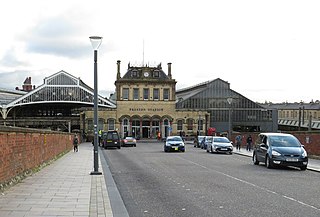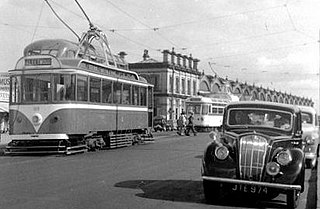Related Research Articles

The Liverpool, Southport and Preston Junction Railway was formed in 1884, and totaled 7 miles. In 1897 it became part of Lancashire and Yorkshire Railway, and on 1 May 1901, its northern terminus switched from Southport Central to Southport Chapel Street.
The Preston and Wyre Railway was promoted to open up agricultural land in the Fylde in Lancashire, access a new port at what became Fleetwood and the Lancaster Canal at Preston: it opened in 1840. An associated company built the dock leading to the company changing its name to the Preston and Wyre Railway, Harbour and Dock Company. Passenger business was more buoyant than expected, and the company built branch lines to the nascent resort of Blackpool and Lytham that opened in 1846. At that time the line was leased by the Lancashire and Yorkshire Railway and later the London and North Western Railway took a share in the lease which was later converted to outright ownership. The Preston and Wyre Railway continued to be jointly owned as the Preston and Wyre Joint Railway.
The East Lancashire Railway operated from 1844 to 1859 in the historic county of Lancashire, England. It began as a railway from Clifton via Bury to Rawtenstall, and during its short life grew into a complex network of lines connecting towns and cities including Liverpool, Manchester, Preston and Blackburn.
The North Union Railway was an early British railway company, operating in Lancashire. It was created in 1834, continuing independently until 1889.
The Lancaster and Preston Junction Railway opened its twenty-mile line in 1840 in Lancashire, England. The company was not commercially successful. When the Lancaster and Carlisle Railway opened in 1846, the L&PJR became part of a busy trunk railway. It had never had the money to provide substantial track equipment or proper signalling arrangements. Most of the line is in use today as part of the West Coast Main Line railway and has been electrified. None of the L&PJR stations is still in use.

Preston railway station in Preston, Lancashire, England, is an interchange railway station on the West Coast Main Line, half-way between London Euston and Glasgow Central. It is served by Avanti West Coast, Northern Trains and TransPennine Express services, plus Caledonian Sleeper overnight services between London and Scotland. It is also served by the Calder Valley line to Leeds and York, and by branch lines to Blackpool, Ormskirk, and Colne.

Southport railway station serves the town of Southport, Merseyside, England. The station is the terminal of the Southport branch of the Northern Line of the electric Merseyrail network, and the diesel-operated Manchester-Southport Line. It is the fourth busiest station on the Merseyrail network. The station and services to Liverpool and Hunts Cross are operated by Merseyrail, with Manchester services operated by Northern Trains.
The West Lancashire Railway (WLR) ran northeast from Southport to Preston in northwest England.

There have been three locations for Fleetwood railway station in Fleetwood, Lancashire, England. The first, from 1840 to 1883, was in Dock Street, opposite Church Street. The second, from 1883 to 1966, was in Queen's Terrace. From 1966 to 1970, the station previously known as Wyre Dock railway station was renamed "Fleetwood".
The Preston and Longridge Railway (P&LR) was a branch line in Lancashire, England. Originally designed to carry quarried stone in horse-drawn wagons, it became part of an ambitious plan to link the Lancashire coast to the heart of Yorkshire. The ambition was never achieved, but the line continued to carry passengers until 1930 and goods until 1967.
Southport Central was a railway station in Southport, Lancashire, England.
Southport Ash Street was a railway station in Southport, Lancashire, England.
Longton Bridge was a railway station on the West Lancashire Railway in England. It served the village of Longton.

Banks railway station was on the West Lancashire Railway in England. It served the village of Banks near Southport.
Churchtown railway station was on the West Lancashire Railway (WLR) in England. It opened in 1878 and served the Southport suburb of Churchtown.
The Bolton and Preston Railway connected Bolton and Preston, in Lancashire, England. Its authorising Act of Parliament forbade its early completion to protect the North Union Railway and imposed other restrictions that limited the success of the B&PR. A change of route was authorised to by-pass the delay making it dependent on the goodwill of the NUR to reach Preston. The NUR saw the B&PR as a competitor and used underhand tactics to harm the success of the B&PR.
Parkside railway station was an original station on the Liverpool and Manchester Railway. It then became the interchange station between lines when the Wigan Branch Railway opened in 1832, moving to the physical junction of the two lines in 1838. The station continued as an interchange until being by-passed in 1847 when a west curve was opened to facilitate north–south links that did not go through the station. Traffic declined further after the Winwick cut-off opened in 1864 leading to closure in 1878.

Lowton railway station served the village named Town of Lowton to the east of Newton-le-Willows and south of Golborne.
Maxwell House railway station served Preston, Lancashire, England, from 1842 to 1844 on the Lancaster and Preston Junction Railway.
River Douglas railway station was a former railway station of the West Lancashire Railway (WLR) on the Southport-Preston Line in North West England, which opened in 1878. The station was near the village of Hesketh Bank, located approximately 550 yards (500 m) to the east of Hesketh Bank station, adjacent to an iron swing bridge on the western bank of the River Douglas.
References
Notes
- ↑ "Opening of the Southport and Preston Railway" . Liverpool Mercury. British Newspaper Archive. 16 September 1882. Retrieved 7 August 2016– via British Newspaper Archive.
- ↑ Willox, William Arthur, ed. (March 1933). "Why and Wherefore - Fishergate Hill". The Railway Magazine. Vol. 41, no. 480. p. 215. ISSN 0033-8923.
- ↑ A photograph can be found in Greville and Holt (1960), p. 199
Bibliography
- Biddle, G. (1989) The Railways Around Preston - A Historical Review, Scenes from the Past: No. 6, Foxline Publishing, ISBN 1-870119-05-3
- Cotterall, J.E. (1982) The West Lancashire Railway, The Oakwood Press, ISBN 0-85361-288-9
- Greville, M.D.; Holt, G.O. (March 1960). "Railway Development in Preston—2" (PDF). The Railway Magazine. Vol. 106, no. 707. pp. 197–203. Archived from the original (PDF) on 28 September 2007. Retrieved 6 August 2007.
- Ordnance Survey First Edition 1:2500 map accessed via MARIO 4 April 2007
| Preceding station | Disused railways | Following station | ||
|---|---|---|---|---|
| Penwortham Cop Lane towards Southport | West Lancashire Railway | Terminus |